Lowcountry Life: Our South Carolina Snakes
I think we can all agree that one of the major appeals of the low country is how close we can always be to nature.
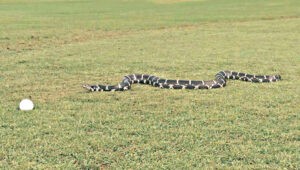
Pinckney Island National Wildlife Refuge, Bear Island Wildlife Management Area, and Hunting Island State Park (soon!) are just a few of the awesome places nearby to experience the wildest and prettiest low country scenes. Of course, nature isn’t restricted to these spots. Now that spring is here, you can enjoy nature in your own backyard… flowers blossoming, birds singing, and snakes slithering.
South Carolina is home to 38 species of snakes, and most of them live in our area. Before you pack your bags and move to the North Pole, can you even count five different kinds you have seen in the wild here? I can only count thirteen species that I’ve met in Beaufort County, and I’m one to go looking for them or have people call me come get them! Our snakes are extremely diverse, from the 12 inch rough earth snake that lives underground and eats earthworms to the 6 foot yellow rat snake that climbs trees to eat squirrels and bird eggs. Their differences mean that few will find your backyard a great place to live, and only a handful are likely to be spotted by you. Luckily those species are normally harmless and are actually really helpful.
Snakes keep a low profile, opting to live under logs, leaf litter, and in dense foliage as they hunt for their small prey. They often have incredible camouflage and will go undetected as you walk by. When wondering where a particular snake might be, consider its prey. Rat and corn snakes are big fans of rodents, so you’re likely to find them patrolling around houses and barns. Black racers are high-energy snakes with excellent eyesight, so they are often spotted in gardens and yards where their favorite prey, lizards, hunt for insects. Bug-loving rough green snakes weave though the trees, their bright green scales blending with vines. Cottonmouths are dark like the wetlands they swim though as they hunt for frogs and fish.
Once you understand preferred habitats and prey, you can attract or deter snakes more easily from your yard. When I was growing up, my dad had a big garden. He made piles of logs we called “toad and lizard hotels”. Bugs, lizards, and hiding places abounded, and I would frequently watch black racers chase skinks and flip logs to find eastern king snakes. Nowadays, whenever Roscoe the resident rat snake comes around, my parents send a picture. Creating a backyard reptile haven can be fun, but if my childhood backyard makes your skin crawl, keep your yard clear of leaf litter, debris piles, and thick foliage. Eliminating prey sources like insects and rodents might require a call to the exterminator, and you might even want to clean up your birdfeeder.
Even our biggest snakes are small compared to us, and they see people as one of their many predators. When they first become aware of a human, snakes will either flee or coil up defensively, ready to strike. Yikes! Strike? Well, yeah, think about it… if a stranger invaded your home and poked you with a stick, grabbed you, or tried cutting you up with a garden tool, wouldn’t you get scared and try to fight back? Without arms or legs, if a snake thinks it’s going to get eaten it will try to fight back if it can’t get away. So, if you see a snake, let it get away. Most bites happen when someone tries handling or killing a snake. When hiking through vegetation or doing yard work, keep an eye out for snakes and consider protective clothing.
No snake wants to hurt people, and all snakes benefit us in some way. Learning more about them will help you appreciate their role in nature and give you a sense of peace when you’re outside. There is no need for you to learn to identify every single snake in the area, but here are the seven you (kids included) should try to get familiar with so you can react accordingly if you spot one. Start with our venomous snakes, then learn to ID our three most commonly encountered non-venomous snakes! For an excellent guide to all our snakes, visit http://srelherp.uga.edu/snakes/ .
Copperhead
You gotta admit, they are pretty! Their light tan-orange back is broken up by brown hourglass shapes.
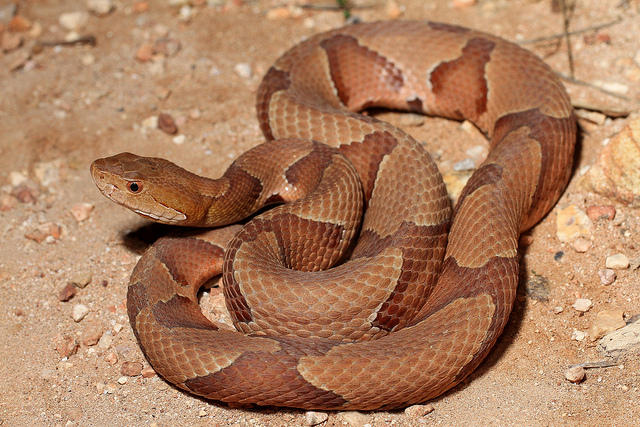
Cottonmouth (Water Moccasin)
Dark all around with faint bands, these wetland-loving swimming snakes will open their mouth wide to show you a big white warning sign to leave them alone.

Rattlesnakes – Diamondback, Canebrake, and Pygmy
Obviously these pit vipers are known for the rattle on their tail! Diamondbacks seem to be most the most common of the three types in the area, but they are very secretive and are rarely seen.
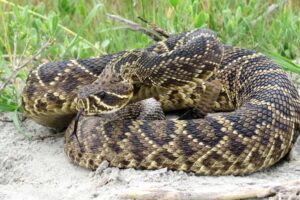
Coral Snake
I often hear folks mess up the rhyme “red on black friend of jack, red on yellow kill a fellow,” so simply remember that if the red and yellow touch like they do on a stop light, then stop. The coral snake’s snout is also black, unlike its mimics.
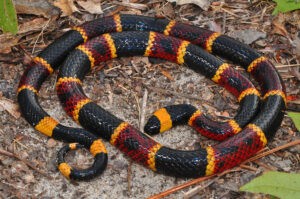
Yellow Rat Snake
Growing six feet or more, these striped serpents are skilled climbers and will search your yard top to bottom for rodents. I find them to be one of our most docile species.
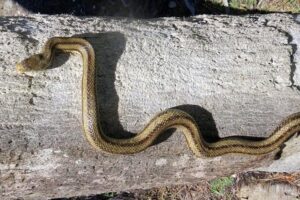
Eastern King Snake
These shiny black beauties with yellow bands are your backyard BFF. While they do eat rodents, they love to eat other snakes including our venomous pit vipers. The more in your yard, the better.
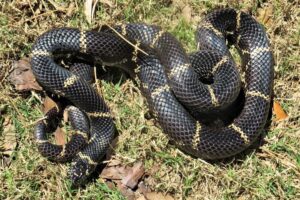
Black Racer
These fast, skinny, black snakes with big eyes and a white underside have major attitude when cornered, but are quick to get away from you.
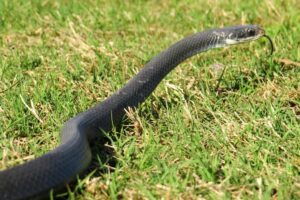
Remember that no snake wants to hurt you, but accidents still happen. It’s a very good idea to keep your eyes open wherever you’re walking throughout the Lowcountry.
Parts of Beaufort are still “in the wild.”
Article by Jessica Miller




